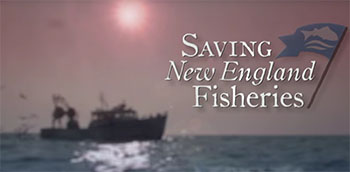Video screenshot from "Saving New England Fisheries" courtesy PBS.I have to say, the trailer for “Saving New England Fisheries” gave me pause.
“We haven’t killed the goose that laid the golden egg yet,” a voice gravely warns as twine spills into the ocean from a gillnetter, “but if we don’t do something pretty soon it’s going to hang it up and give us jellyfish instead.”
The 57-minute documentary debuted last week on PBS stations. It might have been better titled, “Saving New England’s Cod Fishery,” but that’s not a knock on the production.
The notion of jellyfish as deep-sea cockroaches doesn’t do much for me; nor does the idea that we’re headed in that direction. In fact, it’s clear we are not. Fortunately, the documentary does not deliver on this gloomy conceit.
Not that things are peachy. Low quotas for cod, uber-consolidation resulting from catch-share mismanagement, fears about warming seawater and the productivity of the Gulf of Maine, and the specter of $700-a-day observers all loom over New England’s coastal communities.
These contingencies are not lost on the film’s producers, who put their hour to work piecing the entire troubling business together. They even found time to take us to Newfoundland, if only to underscore the historic nature of cod fishing off North America and its importance in fishing communities.
Forever, it seems, Newfoundland was cod heaven – or more correctly, cod fishermen’s heaven – and by the 1960s, nearly a millennium after Leif Erikson and his cohort first caught cod off Labrador, the Newfies were landing upward of 800,000 tons a year. It all came to an end in the early 1990s, with a crash that made headlines around the world.
“Total abuse,” says Newfoundlander Tom Best, who has fished cod since his youth. “We made a mess of it.”
Stocks flatlined, or near about, for the next 20 years. But Newfoundland may have turned the corner, if only just. “Well, the fishery is not coming back yet, but the stocks are coming back,” says George Rose, Ph.D, of Memorial University in St. John’s, Newfoundland.
Whether Newfoundlanders believed all along that cod would come back, I cannot say. New Englanders have seen haddock and redfish rebuild, and most believe cod will as well. And we know that environmental conditions – for example, water temperature, forage availability, and predator abundance – must align with conservation efforts before that wondrous day will be at hand.
Most of this comes through in “Saving New England Fisheries,” and as a result, the documentary is a praiseworthy effort. In addition to pointing out the components of abundance, the producers grasp the nature and extent of the groundfish fishery’s ongoing mismanagement, crystallized most recently in NOAA’s plan to have fishermen pay for $700-a-day observers.
If you’re so inclined, you can find fault with the film — particularly if you’re a fisherman. Bear in mind, though, that the documentary’s intended audience consists of folks we’d like to see better informed about fishing. “Saving New England Fisheries” answers the bell.
If you can’t find it on public television, watch it here:







